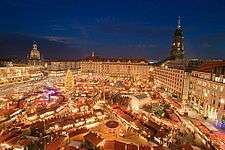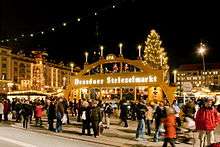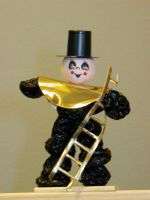Striezelmarkt
The Striezelmarkt in Dresden is considered the first genuine Christmas market in the world.[1] Founded as a one-day market in 1434, it celebrated its 585th anniversary in 2019. Its 240 stands attract about 3 million visitors from all over the world. The annual market lasts throughout the Advent season until Christmas Eve.



History and naming
This market event was first mentioned in 1434, under Friedrich II, Elector of Saxony, when it was held the Monday before Christmas on the Altmarkt square. Originally, it was a one-day market to provide the citizens of Dresden with the meat for the Christmas meal after the pre-Christmas period of fasting.[2]
Over the centuries the Striezelmarkt has developed into a huge event with 240 stands, taking up a large part of Dresden city centre and lasting throughout the Advent period until Christmas Eve. Today the Striezelmarkt attracts 3 million visitors a year from all over the world.[3][4]
The word Striezelmarkt comes from Strüzel or Stroczel, which was the name of a type of cake sold at the market, now famous as Stollen or Christstollen. Stollen is a light airy fruitcake which is quite low in sugar, today available in many parts of the world. The true Dresden Stollen, however, is produced in the city and distinguished by a special seal depicting the city's famous king, August the Strong. [5] The shape of the cake is meant to be reminiscent of the entrance to a mine tunnel (the literal meaning of Stollen) reflecting the area's silver and tin mining history.
Features of today's Striezelmarkt
Today the most famous features of Dresden Striezelmarkt are the world's largest usable Christmas arch with a breadth of 13.5 metres (44 ft) and a height of more than 5 metres (16 ft) and the 14-metre (46 ft) high Erzgebirge Christmas pyramid.[6] Situated on the Dresden Striezelmarkt is a children’s adventure world. Here, the prune chimney sweep’s cottage and the bakery are open for kneading and arts and crafts. Furthermore, there is the puppet theatre, merry-go-round and a children’s railway. On the Dresden Striezelmarkt a daily stage programme takes place. On the Advent weekends are special events like Dresden Stollen Festival and Pyramid and Christmas Arch Festival.[7]
At the centre of the Striezelmarkt stands a 20 metres (66 ft) high spruce, brought from the nearby Tharandt woods and decorated with lights. At the back of the market square there is a painted wooden fairy-tale castle which is also a giant Advent calendar. A door is opened every day by children's entertainers, with a puppet show, and on Fridays there is a visit by Father Christmas himself.
- Wooden ornaments
- Many of the stands at the Striezelmarkt sell wooden ornaments of a huge variety of shapes and sizes.[8] This comes from the area's mining history. Dresden is the largest city near the Erzgebirge, or Ore Mountains, where silver and tin were discovered in around 1168. The discovery brought many miners to the area, who then lost their jobs as the German Peasants' War and competition from abroad took their toll. Needing a new way of earning money, the miners took up woodcarving, incorporating mining symbols and religious elements into their designs. These symbols can still be found in the Christmas ornaments sold at the Striezelmarkt.
- Candle pyramids (Christmas pyramid)
- In many parts of Germany, the candle pyramid (lightstock) is brought out every year to light up the room at Christmas. Two to five round wooden tiers, gradually smaller towards the top, are built onto a central rod which rotates, driven by the heat of candles rising up into a rotor at the top. On each tier there are figures connected with Christmas. The whole ornament is usually about 50 cm (20 in) high, but the tallest pyramid in the world takes pride of place at the Striezelmarkt, towering a full 14 m (46 ft) in the air. Originally, the pyramid was a much simpler affair, simply a frame to hang sprigs of fir upon; the modern-day pyramid did not evolve until the early 19th century.
- Literally, the word Schwibbogen means an arch "hanging" (schweben) above you, between two walls. This candle-holder is indeed arch-shaped, representing the arched entrance to a mine hung with guiding lights; another connection to the area's mining past. Today the "candles" are often lit with electricity, and the scenes cut out of the wooden centre of the arch are not only on mining themes. At night during Advent, nearly every single window in Dresden is lit with these ornaments, traditionally bought at the Striezelmarkt.
- Räuchermann (smoking man)
- Another ornament always present at Christmas-time in Germany, the smoking man is hollowed out with a hole leading to his mouth, hung with a pipe. An incense candle is placed inside him so that he appears to smoke as it burns. There is a wide variety of variations on the smoking man, including old ladies in rocking chairs, Father Christmases, and figures representing nearly every occupation. Smoking men first appeared on the Striezelmarkt in the 19th century.
- Nutcrackers
- The type of nutcracker traditionally sold at the Striezelmarkt, carved and painted with a red coat like a soldier, probably became popular world-wide thanks to Tchaikovsky's "Nutcracker Suite". The first wood turner to carve the ornaments in this form, Wilhelm Friedrich Füchtner from the Ore Mountains, is said to have been inspired by the nutcracker in the story book Tchaikovsky's ballet came from.
Food and drinks

Apart from the famous Stollen, other specialities originate from Dresden and were originally sold at the Striezelmarkt.
- Pflaumentoffel
- Although they are made of prunes, these little figures are really decorations, although they can be eaten after Christmas. Pflaumentoffel means plum devil; (also called Feuerrüpel or Fiery Santa), although they are not meant to be devils or Santas, but chimney sweeps, all dressed in black (the prunes) with a top hat and a brush. Until the 20th century, Pflaumentoffel were sold at the Striezelmarkt on trays carried by children trying to earn some Christmas money. The artist Ludwig Richter famously portrayed these Striezelkinder in 1853 in his woodcut "Ausverkauft wegen Geschäftsaufgabe" ("Sold out as giving up business"). In 1910, however, sale by children was banned at the Striezelmarkt.
- Pulsnitzer Pfefferkuchen (Pulsnitz gingerbread)
- The Christmas market at Nuremberg (Christkindlmarkt) is more famous for its gingerbread known as Lebkuchen, but the Striezelmarkt's gingerbread has nearly as long a history. Pfefferkuchen literally means "pepper cake": the word "pepper" was used to mean any new foreign spice. The gingerbread sold at the Striezelmarkt comes from Pulsnitz, a town about 50 km from Dresden; it was first mentioned as a speciality from Pulsnitz in a decree issued in 1558 allowing bakers to produce it there. Pfefferkuchen are usually filled with marmalade or jam and covered with chocolate. Unlike gingerbread from other countries, the dough does not usually contain any fat, or indeed ginger, but instead nutmeg, cinnamon, ground cloves and allspice, which are added after the dough has been left up to 6 months to mature. In 1780 eight master bakers came personally from Pulsnitz to sell their wares at the Striezelmarkt; today there are many more Pfefferkuchen stands, but the gingerbread is usually sold by hired staff.
- Glühwein (mulled wine)
- One very well-loved tradition on a cold December night in Dresden is drinking steaming mugs of mulled wine at the Striezelmarkt. The hot red wine spiced with cloves and cinnamon is served in specially decorated mugs.
References
- "Christmas Markets in Germany and Europe". The German Way & More. Retrieved 30 October 2019.
- H. Wozel: Der Dresdner Striezelmarkt. Geschichte und Tradition des ältesten deutschen Weihnachtsmarktes. Husum Verlag, Husum 2009, pp. 7-10
- In Photo: European Christmas Market Striezelmarkt Retrieved 27 April 2013
- ABCnews featured Dresden market as having the most authentic holiday market experience in Europe. Holiday Shopping at Europe's Top Christmas Markets Retrieved 27 April 2013
- Dresden Striezelmarkt - Visitor Information Archived 2013-01-08 at the Wayback Machine Retrieved 27 April 2013
- "Archived copy". Archived from the original on 2011-11-16. Retrieved 2011-11-29.CS1 maint: archived copy as title (link)
- Striezelmarkt will accompany this year's Village Lights event Retrieved 27 April 2013
- Stollen and Woodcarvings at the Dresden Striezelmarkt Retrieved 27 April 2013
Further reading
- Heidrun Wozel: Der Dresdner Striezelmarkt. Geschichte und Tradition des ältesten deutschen Weihnmachtsmarktes. Husum Verlag, Husum 2009, ISBN 978-3-89876-455-1
External links
- Official Website
- Germany's Yuletide markets: The fight before Christmas in pictures Retrieved 27 April 2013
- The History of the Dresdner Striezelmarkt Retrieved 27 April 2013
- Dresden Things to do on Yahoo Travel Retrieved 27 April 2013
- Old Market Square (Altmarkt): Traveler Reviews Retrieved 27 April 2013
See also
- List of Christmas markets
- Christmas market
- Cuisine of Germany